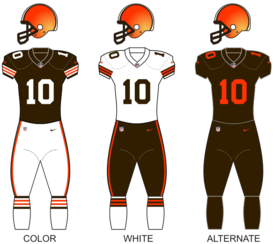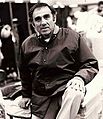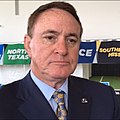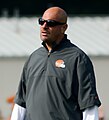Cleveland Browns
| Cleveland Browns | ||
|---|---|---|
| Founded in 1946 playing in Cleveland , Ohio |
||
|
|
||
| league | ||
|
All-America Football Conference (1946-1949)
National Football League (1950-present)
|
||
| Current uniforms | ||

|
||
|
|
||
| Team colors | Brown, orange, white | |
| mascot | CB, Chomps, TD and Trapper | |
| staff | ||
| owner | Jimmy Haslam , Dee Haslam | |
| General manager | Andrew Berry | |
| Head coach | Kevin Stefanski | |
| Team history | ||
|
||
| successes | ||
|
NFL Champions (8) * AAFC Championships (4) 1946 , 1947 , 1948 , 1949
|
||
| Conference winner (11) | ||
| Division Winner (12) | ||
| Play-off appearances (27) | ||
| Stages | ||
|
||

The Cleveland Browns are an American football - team of the National Football League (NFL) and play there in the American Football Conference (AFC) as part of the Northern Division .
The "first" Cleveland Browns were founded in 1946 and were members of the All-America Football Conference , which existed from 1946 to 1949 as a competitive league to the NFL. The team was named after its longtime head coach Paul Brown , who later became the trainer and co-owner of the Cincinnati Bengals . After the NFL and AAFC merged, the Browns joined the NFL in 1950. In 1996 the team was relocated to the Baltimore Ravens , but the naming rights remained with the City of Cleveland . In 1999, a new team finally started playing again under the old name. The Cleveland Browns are one of only four teams that have never competed in a Super Bowl . However, the "first" Cleveland Browns have already won the Super Bowl twice after moving to Baltimore. In addition, the Browns have been very unstable in their choice of quarterbacks since they were founded in 1999: Kevin Hogan was the 28th starting quarterback for the franchise in the last 19 years.
history
In 1944, taxi operator Arthur B. "Mickey" McBride secured the rights to a team in Cleveland that was allowed to compete in the All-America Football Conference . The first general manager and head coach was Paul Brown , who was only 36 and quickly became so popular that the new team was soon to be renamed “Cleveland Browns” in his honor. Since he refused, the owner McBride organized a survey together with a newspaper. In the end, the Cleveland Panthers were chosen . Under the name Cleveland Panthers , however, there had been a team in the American Football League (AFL) and the former owner still had the naming rights. That's why they finally decided on Cleveland Browns . In order not to associate Paul Brown as the namesake, there was an explanation that the team was named after Joe Louis , a dark-skinned boxer called The Brown Bomber. In contrast to many other coaches, who geared their teams to strength and physique, he preferred explosiveness and precision and favored the T-formation, which was rarely played at the time .
With today's Hall of Famers Lou Groza ( offensive tackle ), Otto Graham ( quarterback ), Bill Willis ( guard ), Marion Motley ( fullback ) and Dante Lavelli ( wide receiver ), the Browns won all four AAFC titles from 1946 to 1946 1949 until the league was taken over by the NFL. Was also remarkable that the Browns African Americans Willis and Motley inserting regularly than in the United States nor the segregation existed. The Browns were also successful in the NFL, winning both the NFL Championship Game 1950 , the NFL Championship Game 1954 and the NFL Championship Game 1955 . 1957 a new superstar was signed, running back Jim Brown . With the powerful runner Brown, who gained 12,312 yards of space and averaged 5.2 yards per run attempt to date, the Browns remained a top team, although the gulf between the authoritarian Paul Brown and the team grew bigger and bigger. In 1961, businessman Art Modell bought the Browns and swapped Brown for his longtime assistant Blanton Collier . He led the team to their fourth NFL title in 1964 by winning the NFL Championship Game in 1964 .
When the NFL and the American Football League (AFL) merged, the Browns found themselves in the newly formed AFC (American Football Conference) in 1970 and sank into mediocrity. In the mid-1970s, Brian Sipe established himself as a starting quarterback , with him the resurgent Browns led hard fights with their local rivals, the Pittsburgh Steelers and the Cincinnati Bengals , the new team of Paul Brown. Sipe and the Browns gained a reputation for nerve-wracking comebacks, which is why they were called "Kardiac Kids" (German: heart attack children). The irony of fate was that Sipe (who had just been elected MVP ) made a big blunder in the 1980 AFC play-offs against the Oakland Raiders . In the last minute they were just two points behind Oakland's end zone , but instead of kicker Don Cockroft scoring a short field goal that would have won the game, the Browns dared one last play, whereupon Sipe threw a game-winning interception . With this move called "Red Right 88" a long era of Browns failures began. 1986 the Browns had a strong team around the new quarterback Bernie Kosar . Shortly before the end of the AFC Championship Game, they led at home against the Denver Broncos 20:13 and had the Broncos pinned to their 2-yard line. In a series known as " The Drive, " Broncos quarterback John Elway led his team to 98 yards to a touchdown , and Denver won 23:20 in overtime. Just as close was the elimination the following year, when the Browns met the Broncos again at home: Shortly before the end of the game, running back Earnest Byner fumbled the ball two yards from the end zone, so that the Broncos won 38:33. Byer's mishap is only called "The Fumble" to this day.
After years of mediocrity and the city's unwillingness to renovate the dilapidated stadium, long-time owner Art Modell shocked football fans in Cleveland in 1995 when he surprisingly announced the team's move to Baltimore , creating what is now the Baltimore Ravens . However, Modell encountered bitter resistance, which is why the NFL was forced to intervene in the so-called Cleveland Browns relocation controversy . Model was allowed to leave the city with his management and his players and start over in Baltimore as Baltimore Ravens. The team's name, history and records stayed in Cleveland and the NFL guaranteed the city the return of the Browns if a new stadium was built within three years. Between 1996 and 1999 until they were re-established, the Browns were inactive. In 1999 the game was resumed under head coach Chris Palmer and the new owner Al Lerner with high expectations. In the first game after the re-establishment, you faced old rivals, the Pittsburgh Steelers at home . However, the game was lost with 0:43. At the end of the 1999 regular season there was a record of two wins and 14 defeats.
The following season brought little improvement and they ended with a score of 3-13. Palmer was fired at the end of the season and replaced by Butch Davis . Davis achieved a record of seven wins and nine losses with the Browns in the 2001 season . In 2002 he even reached the play-offs for the first time since 1994 with a score of 9-7 . In the wildcard play-off, the team met the Steelers and lost 33:36. In the following four seasons, the Browns did not make a positive balance in the regular season and clearly missed the play-offs. The 2007 season was the last season in which they could achieve a positive balance (10-6) in the regular season, but this was not enough for the play-offs. Furthermore, since the league was restructured in 2001 at the end of the season, with the exception of the 2007 and 2010 seasons , they always came fourth in their division. One of the reasons for this was the subsequent unsuccessful drafts by the quarterbacks. Brady Quinn was drafted in 2007 , but he only stayed with the Browns until 2009. In 2010 Colt McCoy was drafted, but he only stayed with the Browns until 2012. In 2012, Brandon Weeden was selected by the Browns as the oldest player to date to be selected in the first round. However, Weeden only stayed two years, which is why Johnny Manziel , who won the Heisman Trophy in 2012, was selected in the 2014 draft. However, due to his extroverted lifestyle, Manziel was often criticized by the media and also by his employer, the Cleveland Browns, which is why they fired him after the 2015 season.
The 2016 season ended with just one win against the San Diego Chargers on the penultimate matchday. As a result, however, you could select the first overall in the draft and nine other players in the NFL Draft 2017 with Myles Garrett . Through further swaps and player transfers, the Browns were able to select 9 draft rights in the 2018 NFL Draft . With the then young players and their development, those responsible, especially Chief Strategy Officer Paul DePodesta , who had already used the Moneyball system in the MLB , wanted to rebuild the Browns into a successful team. Overall, after the 2016 season, the Browns' record since their restart in 1999 was 88 to 200 wins. In 2017 Browns-Tackle Joe Thomas injured himself after 10,363 snaps in a row, setting a record that many consider to be a record for the ages. In the entire season, the Browns could not win a game, making them the second team after the Detroit Lions in 2008 , which since the expansion in 1978 to 16 season games produced this negative performance. In the third game of the 2018 season , the Browns won against the New York Jets for the first time after a lean period of 635 days.
Special players
Browns in the Pro Football Hall of Fame
| Jersey number | Surname | position | Active for Cleveland | Year of admission |
|---|---|---|---|---|
| 14/60 | Otto Graham | QB | 1946-1955 | 1965 |
| - | Paul Brown | Head coach | 1946–1962 | 1967 |
| 36/76 | Marion Motley | FB | 1946-1953 | 1968 |
| 32 | Jim Brown | FB | 1957-1965 | 1971 |
| 46/76 | Lou Groza |
T K |
1946-1959 1961-1967 |
1974 |
| 56/86 | Dante Lavelli | End | 1946-1956 | 1975 |
| 53/80 | Len Ford | DE | 1950-1957 | 1976 |
| - | Forrest Gregg | Head coach | 1975-1977 | 1977 |
| 30/60 | Bill Willis | Middle Guard , G. | 1946-1953 | 1977 |
| 77 | Willie Davis | DE | 1958-1959 | 1981 |
| 81 | Doug Atkins | DE | 1953-1954 | 1982 |
| 49 | Bobby Mitchell | KR , HB | 1958-1961 | 1983 |
| 42 | Paul Warfield | WR | 1964-1969, 1976-1977 |
1983 |
| 74 | Mike McCormack | T | 1954-1952 | 1984 |
| 22/52 | Frank Gatski | C. | 1946-1956 | 1985 |
| 18th | Len Dawson | QB | 1960-1961 | 1987 |
| 44 | Leroy Kelly | RB | 1964-1973 | 1994 |
| 72 | Henry Jordan | DT | 1957-1958 | 1995 |
| 44/96 | Don Shula | CB | 1951-1952 | 1997 |
| 29 | Tommy McDonald | WR | 1968 | 1998 |
| 82 | Ozzie Newsome | TE | 1978-1990 | 1999 |
| 64 | Joe DeLamielleurs | G | 1980-1984 | 2003 |
| 66 | Gene Hickerson | G | 1958-1973 | 2007 |
Withdrawn jersey numbers
| Retired Numbers of the Cleveland Browns | ||||
| No. | player | position | Period | |
|---|---|---|---|---|
| 14th | Otto Graham | QB | 1946-1955 | |
| 32 | Jim Brown | RB | 1957-1965 | |
| 45 | Ernie Davis | HB | 1962 | |
| 46 | Don Fleming | S. | 1960–1962 | |
| 76 | Lou Groza | T , K | 1946-59, 1961-67 | |
Venue
The Cleveland Browns played at Cleveland Stadium from their formation in 1946 until Art Modell announced that he and his team would be moving to Baltimore in 1995 . Opened in 1930, Cleveland Stadium was completely out of date by the 1990s. In addition, after the Cleveland Indians moved to their new stadium, the stadium operations also lost their financial base. Even though Art Modell and his team were tied to the outdated venue through a 25-year lease until 2000, he lost confidence in the city, which ultimately ended in the Cleveland Browns relocation controversy . After Art Modell moved to Baltimore, the city built a new stadium within three years, the Cleveland Browns Stadium . In 2013 the name was changed to FirstEnergy Stadium . After various renovation phases, the stadium currently holds 67,895 spectators.
Current squad
Trainer (Head Coaches)
| # | Order of trainers |
| Games | Play as a coach |
| S. | Victories |
| N | Defeats |
| UE | draw |
| Won% | Win rate |
| * | Active exclusively with the Browns as head coach |
| # | Surname | Period | Regular season | Play-offs | Achievements / Awards | reference | |||||||||||
|---|---|---|---|---|---|---|---|---|---|---|---|---|---|---|---|---|---|
| Games | S. | N | UE | Won% | Games | S. | N | ||||||||||
| Cleveland Browns | |||||||||||||||||
| 1 | Paul Brown | 1946–1962 | 214 | 158 | 48 | 8th | .767 | 14th | 9 | 5 |
Sporting News NFL Coach of the Year (1949, 1951, 1953) UPI NFL Coach of the Year (1957) NFL Championships (1950, 1954, 1955) |
||||||
| 2 | Blanton necklace * | 1963-1970 | 112 | 76 | 34 | 2 | .691 | 7th | 3 | 4th | NFL Championship 1964 | ||||||
| 3 | Nick Skorich | 1971-1975 | 56 | 30th | 24 | 2 | .556 | 2 | 0 | 1 | |||||||
| 4th | Forrest Gregg | 1975-1977 | 41 | 18th | 23 | 2 | .439 | - | - | - | AP NFL Trainer of the Year (1976) | ||||||
| 5 | Dick Modzelewski * | 1977 | 1 | 0 | 1 | 0 | .000 | - | - | - | |||||||
| 6th | Sam Rutigliano * | 1978-1984 | 97 | 47 | 50 | 0 | .485 | 2 | 0 | 2 | UPI NFL Trainer of the Year (1979, 1980) | ||||||
| 7th | Marty Schottenheimer | 1984-1988 | 71 | 44 | 27 | 0 | .620 | 6th | 2 | 4th | UPI NFL Trainer of the Year (1986) | ||||||
| 8th | Bud Carson * | 1989-1990 | 25th | 11 | 13 | 1 | .460 | 2 | 1 | 1 | |||||||
| 9 | Jim Shofner * | 1990 | 7th | 1 | 6th | 0 | .143 | - | - | - | |||||||
| 10 | Bill Belichick | 1991-1995 | 80 | 36 | 44 | 0 | .450 | 2 | 1 | 1 | |||||||
| - 1 | 1996-1998 | ||||||||||||||||
| 11 | Chris Palmer * | 1999-2000 | 32 | 5 | 27 | 0 | .156 | - | - | - | |||||||
| 12 | Butch Davis * | 2001-2004 | 58 | 24 | 34 | 0 | .414 | 1 | 0 | 1 | |||||||
| 13 | Terry Robiskie | 2004 | 5 | 1 | 4th | 0 | .200 | - | - | - | |||||||
| 14th | Romeo Crennel | 2005-2008 | 64 | 24 | 40 | 0 | .375 | - | - | - | |||||||
| 15th | Eric Mangini | 2009-2010 | 32 | 10 | 22nd | 0 | .313 | - | - | - | |||||||
| 16 | Pat Shurmur | 2011–2012 | 32 | 9 | 23 | 0 | .218 | - | - | - | |||||||
| 17th | Rob Chudzinski * | 2013 | 16 | 4th | 12 | 0 | .250 | - | - | - | |||||||
| 18th | Mike Pettine * | 2014-2015 | 32 | 10 | 22nd | 0 | .313 | - | - | - | |||||||
| 19th | Hue Jackson | 2016-2018 | 40 | 3 | 36 | 1 | .088 | - | - | - | |||||||
| 20th | Gregg Williams | 2018 | 8th | 5 | 3 | 0 | .625 | - | - | - | |||||||
| 21st | Freddie Kitchens * | 2019 | 16 | 6th | 10 | 0 | .375 | - | - | - | |||||||
| 22nd | Kevin Stefanski | 2020– | |||||||||||||||
Famous fans
The Cleveland Browns were Elvis Presley's favorite club . The reason for this decision of the "King of Rock 'n' Roll " is the fact that his friend Gene Hickerson , with whom he played football regularly in their youth days in Memphis , was signed by the Browns in 1957 and the club until his retirement in 1973 remained faithful. Defense attorney Bobby Franklin , who was under contract with the Browns from 1960 to 1966 , was one of Presley's friends. Another Browns fan is former baseball star Hank Aaron .
In the media
In 2014 the football film Draft Day was released. There Kevin Costner plays the lead role as Sonny Weaver Jr , the fictional general manager of the Browns.
literature
- Jonathan Knight: The Browns Bible: The Complete Game-by-Game History of the Cleveland Browns. Kent State University Press, Kent 2013, ISBN 978-1-60635-170-3 .
Web links
- www.clevelandbrowns.com Official website
- Detailed information on the Cleveland Browns in German
- History of the AAFC ( Memento of February 13, 2015 in the Internet Archive ) (PDF; 61 kB)
Individual evidence
- ↑ Michael David Smith: Kevin Hogan will be Browns' 28th starting quarterback since 1999. In: nbcsports.com. October 11, 2017. Retrieved November 24, 2017 .
- ↑ Dieter Hoch / Holger Korber / Dirk Ladwig: The history of the NFL. From the small beginnings to the rise to the largest professional league in the world. Berlin 2016, page 48f.
- ^ Stefan Feldmann: Cleveland - History. In: bigplay.ch. September 6, 2016, accessed November 24, 2017 .
- ↑ Philipp Joubert: The clever losers. In: spiegel.de. September 8, 2017. Retrieved November 24, 2017 .
- ↑ Cleveland Brown's Franchise Encyclopedia. In: Sports-Reference.com. Retrieved November 24, 2017 .
- ↑ Lukas Lautenschlager: Cleveland - End of Joe Thomas' 10,363 Snap record series. In: bigplay.ch. October 25, 2017. Retrieved November 24, 2017 .
- ^ Mathias Schmid: The first victory after 635 days. In: sueddeutsche.de. September 21, 2018. Retrieved September 21, 2018 .
- ^ Stefan Feldmann: Cleveland - Relocation History of the NFL: The Great Compromise. In: bigplay.ch. April 25, 2017. Retrieved November 24, 2017 .
- ↑ Statistics by Paul Brown . Retrieved October 21, 2015.
- ^ Statistics from Blanton Collier . Retrieved October 21, 2015.
- ↑ statistics Nick Skorich . Retrieved October 21, 2015.
- ^ Statistics by Forrest Gregg . Retrieved October 21, 2015.
- ^ Statistics by Dick Modzelewski . Retrieved October 21, 2015.
- ^ Statistics by Sam Rutigliano . Retrieved October 21, 2015.
- ^ Statistics from Marty Schottenheimer . Retrieved October 21, 2015.
- ^ Statistics from Bud Carson . Retrieved October 21, 2015.
- ↑ Statistics by Jim Shofner . Retrieved October 21, 2015.
- ^ Statistics by Bill Belichick . Retrieved October 21, 2015.
- ↑ Statistics by Chris Palmer . Retrieved October 21, 2015.
- ^ Statistics from Butch Davis . Retrieved October 21, 2015.
- ↑ Statistics by Terry Robiskie . Retrieved October 21, 2015.
- ↑ statistics Romeo Crennel . Retrieved October 21, 2015.
- ↑ Statistics by Eric Mangini . Retrieved October 21, 2015.
- ↑ Statistics by Pat Shurmur . Retrieved October 21, 2015.
- ↑ “Black Monday” costs seven coaches the job. In: derStandard.at . January 1, 2013, accessed January 1, 2013 .
- ↑ Rob Chudzinski's statistics . Retrieved October 21, 2015.
- ^ Statistics from Mike Pettine . Retrieved October 21, 2015.
- ↑ Statistics by Hue Jackson . Retrieved January 5, 2018.
- ^ Statistics by Gregg Williams . Retrieved November 2, 2019.
- ↑ Statistics from Freddie Kitchens . Retrieved January 11, 2020.
- ↑ Statistics by Kevin Stefanski . Retrieved February 6, 2020.
- ↑ June Moore (in collaboration with Kathy Westmoreland): Kathy Westmoreland : Elvis' voice of an angel , Ju'Mel Publishing, USA, June 2010, p. 159 / ISBN 978-0-9827845-0-1
- ↑ TOP 20 surprising Elvis Facts (English; article from January 7, 2009)
- ↑ Dan Coughlin: Gene Hickerson: Elvis Took His Calls (English; article from October 24, 2011)
- ↑ Bill Lubinger: Sharing the pain: Cleveland Browns' failures do not just depress the common fan, but the uncommon celebrity, too. November 8, 2009, accessed November 28, 2015 .














